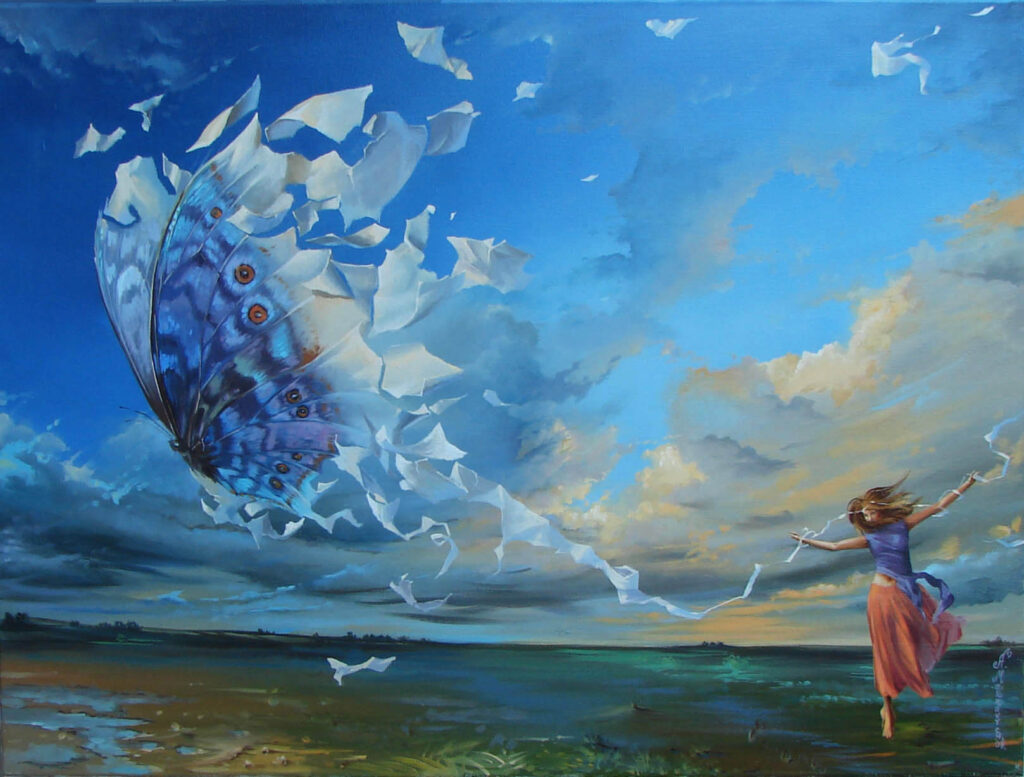Reading visual art: 175 Butterfly, natural

With the Age of Enlightenment, former associations of butterflies became obscure, and they were most often included in increasingly faithful paintings of natural history.
Johann Amandus Winck (1748–1817), Flowers and Fruits on a Stone Ledge with Butterflies and Mice (1804), oil on cradled panel, 31.1 x 45.7 cm, location not known. Wikimedia Commons.
Painted in 1804, Johann Amandus Winck’s magnificent still life of Flowers and Fruits on a Stone Ledge with Butterflies and Mice makes good use of two butterflies, a housefly (perhaps a vanitas reference), a mouse and a snail.
William Holman Hunt (1827–1910), Our English Coasts, 1852 (Strayed Sheep) (1852), oil on canvas, 43.2 x 58.4 cm, The Tate Gallery (Presented by the Art Fund 1946), London. © The Tate Gallery and Photographic Rights © Tate (2016), CC-BY-NC-ND 3.0 (Unported), http://www.tate.org.uk/art/artworks/hunt-our-english-coasts-1852-strayed-sheep-n05665
For William Holman Hunt, in his Our English Coasts, 1852, native species of butterfly were a symbol of the British countryside. Composed from several passages from different motifs, it was assembled in a similar way to the Pre-Raphaelites’ figurative works. Hunt went to great lengths to work from nature: the peacock butterflies at the lower left were one of the last details to be completed, and were painted from a single live specimen the artist examined indoors after the rest of the painting was all but complete.
Gustave Doré (1832–1883), Summer (c 1860-70), oil on canvas, 266.4 x 200.1 cm, Museum of Fine Arts Boston, Boston, MA. Wikimedia Commons.
One of the few paintings that captures the experience of dense clouds of butterflies is Gustave Doré’s Summer from about 1860-70. Set in what appears to be an upland or alpine meadow, its butterflies look like large flowers that have taken to the air.
Charles Edward Perugini (1839–1918), Ephemeral Joy (date not known), oil on canvas, dimensions not known, Matsuoka Museum of Art, Tokyo, Japan. Image by Daderot, via Wikimedia Commons.
In Charles Edward Perugini’s undated Ephemeral Joy, a young woman who has been picking flowers in a garden pauses with a brimstone butterfly on the back of her hand. This species was seen as quintessentially British, although it’s widespread throughout Europe, Asia and North Africa.
Bruno Liljefors (1860–1939), Redstarts and Butterflies. Five studies in one frame (1885), oil on panel, 26.5 x 17 cm, Nationalmuseum, Stockholm, Sweden. Image by Erik Cornelius, via Wikimedia Commons.
Although numerous paintings of butterflies had been made from dead specimens, some of the earliest to attempt to show them in realistic environments appeared in the late nineteenth century, thanks to new wildlife artists like the masterly Bruno Liljefors. Redstarts and Butterflies, from 1885, shows what the artist called ‘five studies in one frame’, five separate studies from nature combined into a single image, including this very dark small tortoiseshell butterfly, which is about to become a meal for one of the insectivorous redstarts.
Vincent van Gogh (1853–1890), Giant Peacock Moth (1889), oil on canvas, 33.5 x 24.5 cm, Van Gogh Museum, Amsterdam. Wikimedia Commons.
Late in his career, Vincent van Gogh painted the largest European species of moth, the giant peacock moth, in 1889. Its wingspan can reach 20 cm (8 inches).
Vincent van Gogh (1853–1890), Butterflies and Poppies (1890), oil on canvas, 34.5 x 25.5 cm, Van Gogh Museum, Amsterdam, The Netherlands. Wikimedia Commons.
The following year, van Gogh painted Butterflies and Poppies (1890), showing what are probably two clouded yellow butterflies rather than brimstones. This appears to have been painted on unprimed canvas.
Fujishima Takeji (1867-1943), 蝶 藤島武二筆 Butterflies (1904), media and dimensions not known, Private collection. Wikimedia Commons.
The Japanese Western-style artist Fujishima Takeji 藤島武二 painted Butterflies in 1904, just before he travelled to Paris to study at the École des Beaux-Arts. Like Doré’s painting above, this shows a dense cloud of butterflies gathering around flowers.
Odilon Redon (1840–1916), Butterflies (c 1910), oil on canvas, 73.9 x 54.9 cm, The Museum of Modern Art, New York, NY. Wikimedia Commons.
In the twentieth century, butterflies provided an opportunity for artistic invention to take flight. Odilon Redon’s Butterflies, from around 1910, shows a highly imaginative collection of butterflies, flowers, plants, and rocks, many being outlined to emphasise their form.
Anastasiya Markovich (1979-), Effect of Butterfly (date not known), oil on linen, 60 x 80 cm, location not known. Courtesy of Picture Labberté K.J. and the artist, via Wikimedia Commons.
In Anastasiya Markovich’s recent Effect of Butterfly, the insect’s wings are breaking up into shreds of unreality.
My final painting of this selection is in many ways the most fascinating, based on scenes from one of William Shakespeare’s plays set in faerie style by Richard Dadd during his confinement in London’s Bethlem hospital for the mentally ill.
Richard Dadd (1817–1886), Contradiction: Oberon and Titania (1854-8), oil on canvas, 61 x 75.5 cm, Private collection. Wikimedia Commons.
Dadd’s Contradiction: Oberon and Titania from 1854-8 develops his early faerie paintings into a new and unique style, and was painted for the hospital’s first resident Physician-Superintendent, William Charles Hood.
Dadd takes its theme from Shakespeare’s Midsummer Night’s Dream, and there’s hardly a square millimetre of canvas into which he hasn’t squeezed yet another curious detail. Like other great imaginative painters such as Bosch before, Dadd’s dense details dart about in scale: there are tiny figures next to huge leaves and butterflies, and towards the top of this tondo these distortions of scale generate an exaggerated feeling of perspective.
The contradiction of the title refers to the battle of wills between Oberon and Titania centred on an Indian boy. Titania, inevitably somewhat masculine, stands just to the right of centre, the boy bearing her skirts. To the left of centre is the bearded figure of Oberon, an elfin lad holding him back by his right arm. At the right are Helena and Demetrius whose love remains unrequited despite Helena’s efforts. Beyond those central figures is an overwhelming mass of detail, miniature scenes and stories involving hundreds of extras, flowers (including the ‘Morning Glory’ convulvulus at the feet of Titania), leaves, an ornate swallowtail butterfly, a floating jade egg, fungi, and far more.
I think that’s the best place to end.




